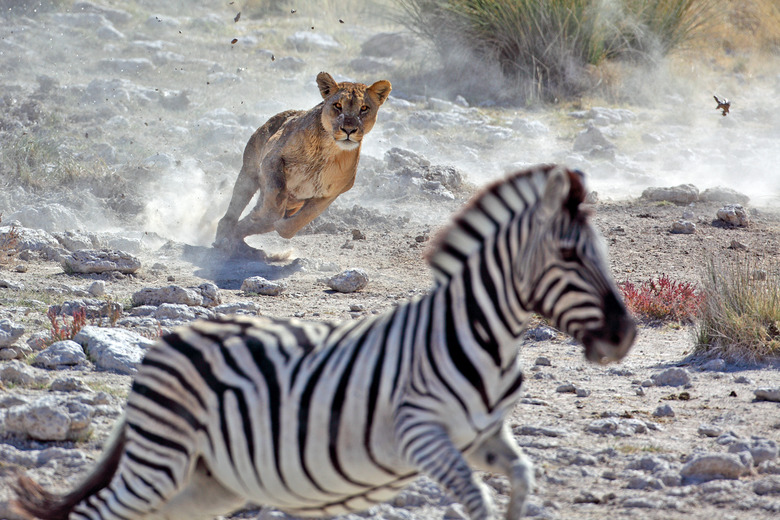How Does Energy Flow Through A Food Chain?
The "who eats whom" relationships symbolized in the model of a food chain gives the Earth's ecosystems some of their truly fundamental structures. The food chain in visible action might be an eagle swooping on a jackrabbit or a shark gulping its way through a school of herring, but you can also visualize a more intrinsic, underlying movement; that of the energy, originally generated by nuclear reactions in the Sun, that flows through an ecosystem to power that system's life forces.
Energy in Ecosystems
Energy in Ecosystems
Electromagnetic energy from the sun fuels nearly all of the planet's ecosystems, though there are deep-sea communities that instead tap into the energy delivered by hydrothermal vents. Green plants "fix" incoming solar energy; that is, they capture it and convert it through the process of photosynthesis into chemical energy contained within carbohydrates. The energy in those compounds' chemical bonds then nourishes other organisms that, to get it, consume plants or plant-eating creatures, which include the invertebrates, fungi and microbes that decompose dead organic matter.
Because decomposition produces essential inorganic nutrients used by plants to drive photosynthesis, matter cycles through an ecosystem. Energy, by contrast, isn't recycled but rather flows through the system: The mechanics of living – using chemical energy to power the critical processes that maintain an organism's organization – produce heat as the ultimate byproduct, and this can't be converted back into a form of energy usable by life forms. Thus plants require a steady supply of sunlight to fuel photosynthesis, and non-photosynthetic organisms require a steady intake of food to obtain new energy.
Producers, Consumers and Decomposers
Producers, Consumers and
Decomposers
Because they manufacture usable chemical energy from the sun's electromagnetic radiation, green plants and other photosynthetic organisms such as algae and cyanobacteria are called "producers." Non-photosynthetic organisms that either directly or indirectly rely on the energy fixed by producers are an ecosystem's "consumers." An herbivore such as a deer or tortoise eats plants to obtain that energy; it's a primary consumer because it consumes the producer itself. An animal that preys on an herbivore, such as a carnivore like a spider or tiger, is a secondary consumer; carnivores also eat other carnivores, of course – a great horned owl preying on a weasel, say – so you can also talk about tertiary consumers.
Many animals, from yellow-jackets to brown bears, eat both plant and animal matter; these omnivores therefore serve as both primary and secondary consumers. Decomposers are a special class of consumers that feed on dead plant and animal matter, converting organic material to inorganic gases and minerals that can be recycled as nutrients back into the system.
Keep in mind the food chain doesn't involve only an organism completely consuming another. Herbivores often don't destroy the individual plants they browse or graze, and many parasites don't outright kill the host organisms they draw sustenance from. Furthermore, there are many mutualistic relationships in which one life form draws energy from another while providing some sort of service in exchange; for example, the fungi that colonize plant roots and obtain energy from them while boosting the plant's ability to uptake water and nutrients.
Food Chains and Biomass Pyramids
Food Chains and Biomass Pyramids
The pathway of energy from producers to consumers to decomposers forms a food chain. A simple one might encompass grass to impala to cheetah. In reality, organisms often eat and are eaten by multiple other organisms, making a food web – basically a bunch of interwoven food chains – the more detailed model, but the basic linear structure of a food chain is still useful for tracing ecosystem energy flow. Each rung of a food chain represent a trophic level: A producer occupies the basal trophic level, a primary consumer the next and so on.
A related concept is the biomass or energy pyramid, which symbolizes the relative proportion of organisms at different trophic levels in an ecosystem. Though not a hard and fast rule, producers typically vastly outnumber primary consumers, and primary consumers vastly outnumber secondary consumers. This is because of the inherent inefficiency of energy transfer through an ecosystem. On average, photosynthesis fixes well under 1 percent of Earth's incoming solar energy, and of that only a small proportion of the resulting chemical energy actually funnels into the food chain; much of it the plant uses for itself. At each stage of a food chain, energy is "burned" for an organism's respiration and lost to heat, so decreasing amounts are available to consumers at higher trophic levels. A standard approximation is that a mere 10 percent of the energy stored at one trophic level passes to the next one up. Roughly speaking, this is why a single orca requires, via the intervening food-chain links of, say, shrimp, fish and seals, multitudes of plankton to sustain itself.
References
- Marietta College: Energy Flow Through the Ecosystem
- Physical Geography: A Landscape Appreciation; Tom L. McKnight
- An Introduction to Environmental Systems; G.H. Dury
- The University of Michigan: The Flow of Energy — Primary Production to Higher Trophic Levels
Cite This Article
MLA
Shaw, Ethan. "How Does Energy Flow Through A Food Chain?" sciencing.com, https://www.sciencing.com/energy-flow-through-food-chain-7321058/. 17 April 2018.
APA
Shaw, Ethan. (2018, April 17). How Does Energy Flow Through A Food Chain?. sciencing.com. Retrieved from https://www.sciencing.com/energy-flow-through-food-chain-7321058/
Chicago
Shaw, Ethan. How Does Energy Flow Through A Food Chain? last modified August 30, 2022. https://www.sciencing.com/energy-flow-through-food-chain-7321058/
